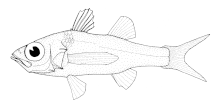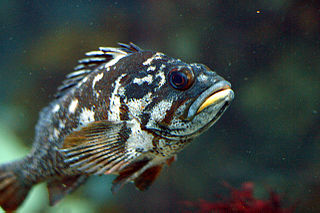
Sebastinae is a subfamily of marine fish belonging to the family Scorpaenidae in the order Scorpaeniformes. Their common names include rockfishes, rock perches, ocean perches, sea perches, thornyheads, scorpionfishes, sea ruffes and rockcods. Despite the latter name, they are not closely related to the cods in the genus Gadus, nor the rock cod, Lotella rhacina.
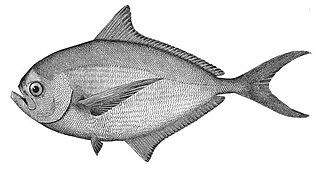
Pomfrets are scombriform fish belonging to the family Bramidae. The family currently includes 20 species across seven genera. Several species are important food sources for humans, especially Brama brama in South Asia. The earlier form of the pomfret's name was "pamflet", a word which probably ultimately comes from Portuguese pampo, referring to various fish such as the blue butterfish. The fish meat is white in color.

Acropomatidae is a family of ray-finned fish in the order Acropomatiformes, commonly known as lanternbellies. Acropoma species are notable for having light-emitting organs along their undersides. They are found in all temperate and tropical oceans, usually at depths of several hundred meters. There are about 32 species in as many as 9 genera, although some authorities recognise fewer genera than Fishbase does.
Zoarces is a genus of marine ray-finned fishes belonging to the family Zoarcidae, the eelpouts. It is the only genus in the subfamily Zoarcinae. These eelpouts are found in the northern Atlantic and northern Pacific Oceans.
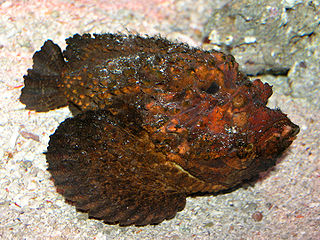
Synanceiinae is a subfamily of venomous ray-finned fishes, waspfishes, which is classified as part of the family Scorpaenidae, the scorpionfishes and their relatives. These fishes are found in the Indo-Pacific oceans. They are primarily marine, though some species are known to live in fresh or brackish waters. The various species of this family are known informally as stonefish, stinger, stingfish and ghouls. Its species are known to have the most potent neurotoxins of all the fish venoms, secreted from glands at the base of their needle-like dorsal fin spines. The vernacular name, stonefish, for some of these fishes derives from their behaviour of camouflaging as rocks. The type species of the family is the reef stonefish.

Anthias are members of the family Serranidae and make up the subfamily Anthiinae. The name Anthiidae is preoccupied by a subfamily of ground beetles in the family Carabidae created by Bonelli in 1813 and this grouping should be called the Anthiadinae. However, both the 5th Edition of Fishes of the World and Fishbase give the Serranid subfamily as "Anthiinae".

Congiopodidae, commonly known as pigfishes, horsefishes and racehorses, is a family of ray-finned fish classified with in the order Perciformes. These fishes are native to the Southern Hemisphere.
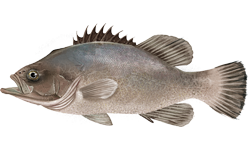
The wreckfish are a small group of ray-finned fish in the genus Polyprion, belonging to the monotypic family Polyprionidae in the order Acropomatiformes.
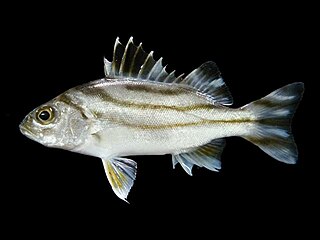
Grunters or tigerperches are ray-finned fishes in the family Terapontidae. This family is part of the superfamily Percoidea of the order Perciformes.
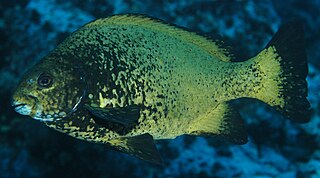
The sea chubs, also known as rudderfish and pilot fish and in Hawaiian as enenue or nenue, are a family, Kyphosidae, of fishes in the order Perciformes native to the Atlantic, Indian and Pacific Oceans usually close to shore in marine waters.

Howella is a genus of ray-finned fish in the family Howellidae, the oceanic basslets. They are found in all oceans.

Zaniolepis, the combfishes, is a genus of marine ray-finned fish, it is one of two genera in the family Zaniolepididae. These fishes are native to the eastern Pacific Ocean. Z. frenata that was a source of food to the Native American inhabitants of San Nicolas Island off the coast of southern California, United States during the Middle Holocene.

The Scorpidinae, commonly known as halfmoons, knifefishes, and sweeps, are a subfamily of the family Kyphosidae, the sea chubs, a family of marine fish in the order Perciformes. The Scorpidinae are distributed throughout the Pacific and east Indian Oceans, with species occurring in the waters of North America, South America, Asia, Australia, and numerous islands. Most inhabit the continental shelf in shallow rock and kelp reefs and deeper offshore reefs, whilst others are found well offshore in a pelagic setting. Most of the Scorpidinae are carnivorous, taking a variety of small crustaceans, although some are partly herbivorous. A number of the larger species are fished commercially and recreationally, and are considered good table fish.

Hemilepidotus, the Irish lords, is a genus of ray-finned fishes belonging to the family Agonidae, the poachers and sea ravens. These fishes are found in northern Pacific, northern Atlantic and Arctic oceans.

Pleurogrammus is a genus of ray-finned fishes belonging to the family Hexagrammidae, the greenlings, known as Atka mackerels. These fishes are found in the northwestern Pacific Ocean.
Bathysphyraenops is a genus of ray-finned fish in the family Howellidae, the oceanic basslets. They are native to the deep waters of the tropical oceans.

Kyphosus is a genus of sea chubs native to the Atlantic, Indian and Pacific oceans. It is the only genus in the subfamily Kyphosinae of the family Kyphosidae.

Apodichthyinae is a subfamily of marine ray-finned fish belonging to the family Pholidae, the gunnels. These fishes are found in the North Pacific Ocean.

Chirolophinae is a subfamily of marine ray-finned fishes, classified within the family Stichaeidae, the pricklebacks or shannies. These fishes are found in the North Pacific, Arctic and North Atlantic Oceans.
Neozoarcinae is a subfamily of marine ray-finned fishes, classified within the family Stichaeidae, the pricklebacks or shannies. These fishes are found in the North Pacific Ocean.
